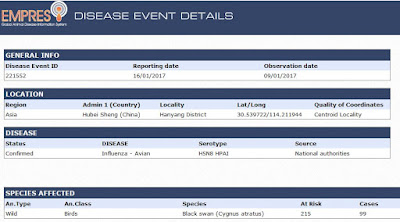 |
| Credit Wikipedia |
#12,035
When we talk about `black swan events', this isn't exactly what we have in mind, but it is still a worrisome event when China reports the sudden deaths of 99 black swans in Wuhan, the largest city in, and capital of Hubei, due to avian H5N8.
First a short notice from China's Ministry of Agriculture, followed by an equally brief FAO announcement, then I'll have a bit more.
Detection of avian influenza virus by dead black swan in Hanyang district, Wuhan city, Hubei province
Date: 2017-01-18 14:46
Recently, Hanyang District, Wuhan City, Hubei Province, the breeding of black swans died, as of January 9, the cumulative death of 99 only. On January 16, the National Avian Influenza Reference Laboratory detected H5N8 subtype highly pathogenic avian influenza virus from samples of dead black swan samples submitted to Hubei for inspection.
At present, the veterinary department of Hubei Province has been in conjunction with the forestry sector in accordance with the relevant emergency plans and technical specifications requirements, and do a good job in emergency response work has been culling and harmless treatment of the swan 215. The investigation, the local birds were not found abnormalities.
The following notice was posted by the FAO this morning as well.
We continue to see unusually high mortality in wild and migratory birds from both H5N6 and H5N8, compared to previous years. During the six months during which H5N8 (and its reassorted offspring H5N2) decimated the US poultry industry (Dec 2014-June 2015), fewer than 100 dead or dying birds were found infected across the United States.
Reports from Korea during their initial outbreak during the winter and spring of 2014 indicated only limited wild bird die offs, and only a small number of infected birds were discovered in Europe the following winter.When H5N8 returned this fall to Europe, it produced scores of large die offs of migratory birds, including waterfowl which are normally fairly resistant to avian influenza, killing thousands of birds. A couple of weeks ago, in EID Journal: Reassorted HPAI H5N8 Clade 2.3.4.4. - Germany 2016,
we looked at evolutionary changes in the virus that account for this increased virulence, with the authors writing:
A new reassortant influenza A(H5N8) virus is responsible for the recent HPAIV outbreak in Germany. The observed differences in pathogenicity for a broad spectrum of waterfowl compared with that of H5N8 viruses from 2014–2015 correlate with a new genome composition of these viruses.It will be of interest to see if these same (or at least similar) changes are found in viruses found in these black swans in Hebei, 7500 km away.
